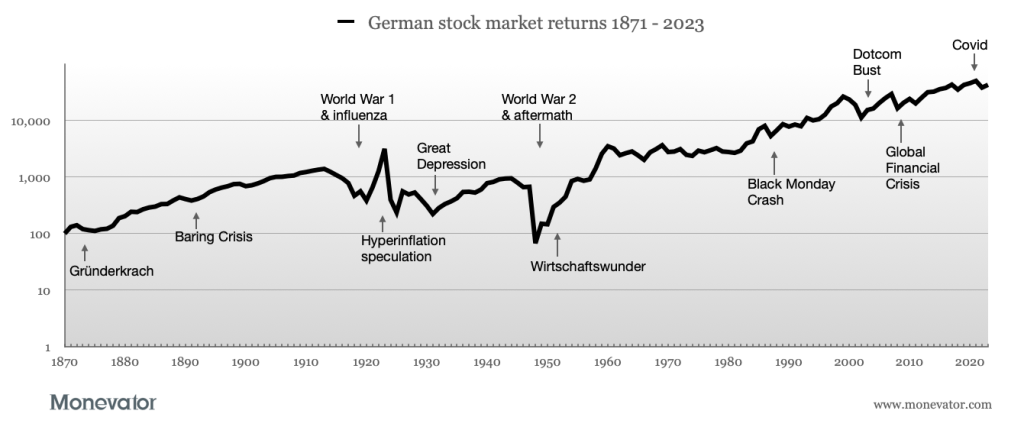
The time has come to talk about commodities. Chances are you don’t hold a position in this asset class, despite its low correlation with equities and bonds. And despite the fact that it’s often lauded as an inflation hedge.
If you’ve looked into commodities at all – beyond flirting with gold – then you probably walked hurriedly away murmuring, “nothing to see here” at the sight of the -60% car crash that totalled the market from 2008 to 2020.
But then came inflation – and over the next two years commodities smashed it. Gains north of 30% in 2021 and 2022 even while other assets bombed.
Are we all missing an important diversifying asset that actually does defend against inflation?
Keeping the faith
Even while investors were throwing their unwanted commodities overboard, investment academics kept at work, cracking the code of this most misunderstood of asset classes.
Were commodities really broken? Or was the recent twelve-year bear market just a completely normal case of investment risk incarnate?
As it turns out, the academic research suggests the stench of complexity and negativity hanging around commodities masks a valuable portfolio diversifier that can deliver strong long-term returns.
Which brings us to this article – the first in a Monevator mini-series to explain, demystify, and marshall the data on commodities.
Because – whisper it – this may well be the ‘alternative’ asset class many of us are searching for.
Here’s how the series will pan out:
Part one (this piece) is a commodities explainer. Let’s see how the asset class works.
Part two digs into the research showing the role commodities can play as a strategic diversifier.
Part three is on the difference commodities can make to the portfolio returns of UK investors.
Part four concentrates on commodities’ record versus UK inflation.
Part five will scrutinise what investable commodities products are available.
Right then. On with the explainer!
What commodities investing actually means
Investing in commodities as an asset class means buying funds with exposure to raw materials such as:
Energy products – for example oil and gas
Staple crops – soybeans, wheat, cotton, sugar, and more
Livestock – things that walk, like cattle and hogs
Industrial metals – aluminium and copper and the rest
Precious metals – gold, platinum, and other shiny stuff
An investment vehicle that holds a mix of these categories is known as a broad commodities fund. Passive investing versions exist as commodities ETFs.
Single commodity ETCs1 exist too. But they don’t offer the same diversification benefits as a broad commodities product.
So far so good. But from here, commodities funds begin to sound like the type of financial engineering that ends with the investing equivalent of the Titanic sliding to the icy depths.
Bear with me though. There’s a strong economic rationale for commodities investing, plus a recently unearthed and impressive historical track record to support it.
Commodity futures trading
The first weirdness to dissect is that commodity funds and ETFs don’t literally own herds of cows or fleets of oil tankers. Agribusiness and oil refining is not their bag.
To avoid getting their hands dirty, they invest in commodity futures contracts.
Commodity futures are derivatives that commit a fund to buying a quantity of a particular commodity at a specific price on a specific date. Say, two months from now.
However the fund has no notion of ever taking delivery of said commodities.
To avoid their offices being overrun by cows, the canny fund manager sells their futures contract before the due date. But they’ll maintain their exposure to steers or longhorns or whatever by buying into a new, longer-dated futures contract. This, too, will be sold, further down the line, as the thunder of hooves draws near.
This manoeuvre is called rolling. It means the fund continually tracks each commodity – via a chain of ever-expiring future contracts – without ever being saddled with the costs or the raw reality of buying in bulk.
Back to the futures
You might wonder why do futures even exist?
Well, commodity producers want to hedge against the possibility of adverse price movements before they’re ready to sell.
Meanwhile, buyers who actually need commodities to run their business must ensure continuity of supply.
Investors get involved in the middle because there’s money to be made in supplying liquidity to the commodity futures market.
Why commodities investing is profitable
The most counterintuitive thing you’ll discover today is that the return of a commodities futures fund or ETF has very little to do with the spot price of the underlying raw materials.
Spot price moves make up only a small component of a total return that is highly volatile but – over the long-term – only marginally less profitable than equities. And far superior to bonds.
The total returns of a broad commodities futures fund derives from three sources:
Spot price changes
Interest on collateral
The roll return (related to the rolling manoeuvre mentioned above)
The spot price is simply today’s price for a barrel of oil, or a bushel of wheat, or a ton of coffee.
Interest is earned because a commodities fund diverts some of its capital into purchasing collateral that underwrites the risk taken on its futures contracts.
But the roll return is the main source of long-term excess profits for investors.
The roll return is the profit (or loss) the fund makes on trading futures contracts.
Remember it’s a perpetual motion machine that constantly buys contracts with delivery dates some way off in the distance. Those self-same contracts are then sold off as D-Day looms, and are replaced by longer-dated versions.
You’ve got to roll with it
Roll return is the difference between the price earned on the sold contract and the price paid for its replacement.
If the short-dated contract is sold for a higher price than its long-dated replacement then the market for that commodity’s futures is described as being in backwardation.
If the short-dated contract is sold for a lower price than its replacement, then the market for that commodity’s futures is described as being in contango.
Backwardation good, contango bad.
A state of backwardation indicates the market expects the spot price to fall. Hence more distant contracts are cheaper than short-dated ones, and the fund should make a positive roll return when it sells and replaces the maturing contract.
A state of contango indicates the market expects the spot price to rise. Now we’re in the reverse situation and facing a negative roll return when the short-dated contract is replaced with a more expensive one.
Individual commodity futures markets flip between the two conditions depending on supply and demand.2
From our perspective, the important point is that commodity investment returns benefit from backwardation and are dragged down by contango.
These states can last for long periods. The atrocious returns of commodity funds post-2007 was often linked to contango in the oil market for years after the Global Financial Crisis.
However while individual commodity futures markets are highly volatile, they also enjoy low correlations with each other.
This enables diversified commodity funds to descend into the broad commodities market like claw-craned arcade grabbers.
The claw retracts clutching handfuls of winners and losers but, over time, the gains provide ample compensation for investors.
Commodities investing: the underlying rationale
There are two competing theories that seek to explain why commodities investing is profitable.
The first is the theory of normal backwardation, attributed to John Maynard Keynes.
Commodity producers want to lock in a minimum price to insure themselves against a dramatic drop in the value of their output, say at harvest time.
Thus producers hedge against the possibility of loss by selling futures contracts to investors. They pledge their product for a price that could be lower than the one they’d receive if they waited until delivery day.
Investors expect to be rewarded for offering this insurance and for taking on the risk that they may be overpaying for the commodities. Thus they set the futures price below the spot price they expect to prevail when the contract matures.
If the investor has made a shrewd guess then they can theoretically sell the commodities for a profit.
Although in reality, as discussed, they’ll punt the contract to a buyer who genuinely wants the goods. All being well, the investor still pockets a tidy profit as the value of the maturing futures contract converges upon the spot price.
The second rationale for commodities investing is known as the theory of storage.
In this conception, the value of short-dated futures is bid up by commodity buyers who cannot risk their production line slowing down for want of raw materials.
Once again, investors benefit if they’re able to purchase long-dated contracts for a relatively low cost, and then later cash in, when buyers flood into the market like forgetful husbands who’ll pay stupid prices for flowers come Valentine’s Day.
Wake up and smell the coffee, the crude oil, and the hogs
These theories help explain why a long-term risk premium should exist for commodities futures – making them more profitable than sitting in cash.
Without the promise of that premium return, there’d be no reason for investors to create the market. Eventually it would dry up.
But theory is not enough. We rational investors want to see it backed up by a historical track record of positive results.
It turns out there is one. That will be the topic of my next commodities post.
Take it steady,
The Accumulator
Exchange Traded CommoditiesThe grubby realities of handling real-world commodities are also a factor. For instance, it costs money to store oil. And wheat rots.
The post Commodities investing: why we’re missing a trick appeared first on Monevator.



